Disorders of the CNS and GI Tract: A Comparative Analysis
VerifiedAdded on 2020/07/22
|12
|1895
|496
Report
AI Summary
This report examines various disorders affecting the gastrointestinal tract (GIT) and the central nervous system (CNS). It begins with a description of the GIT and associated disorders such as Celiac disease, Crohn’s disease, and Diverticulitis, including their pathophysiology, signs, symptoms, and medications. The report then shifts focus to the CNS, detailing disorders like Schizophrenia, Epilepsy, and Alzheimer’s disease, similarly outlining their characteristics and treatments. The study emphasizes the importance of understanding the causes, symptoms, and treatments for these conditions, highlighting the need for counselling services to improve patient outcomes. The report includes medication details and concludes with a discussion on the importance of holistic patient care, including counselling, to address these complex health issues. The report uses several references to support the information provided.
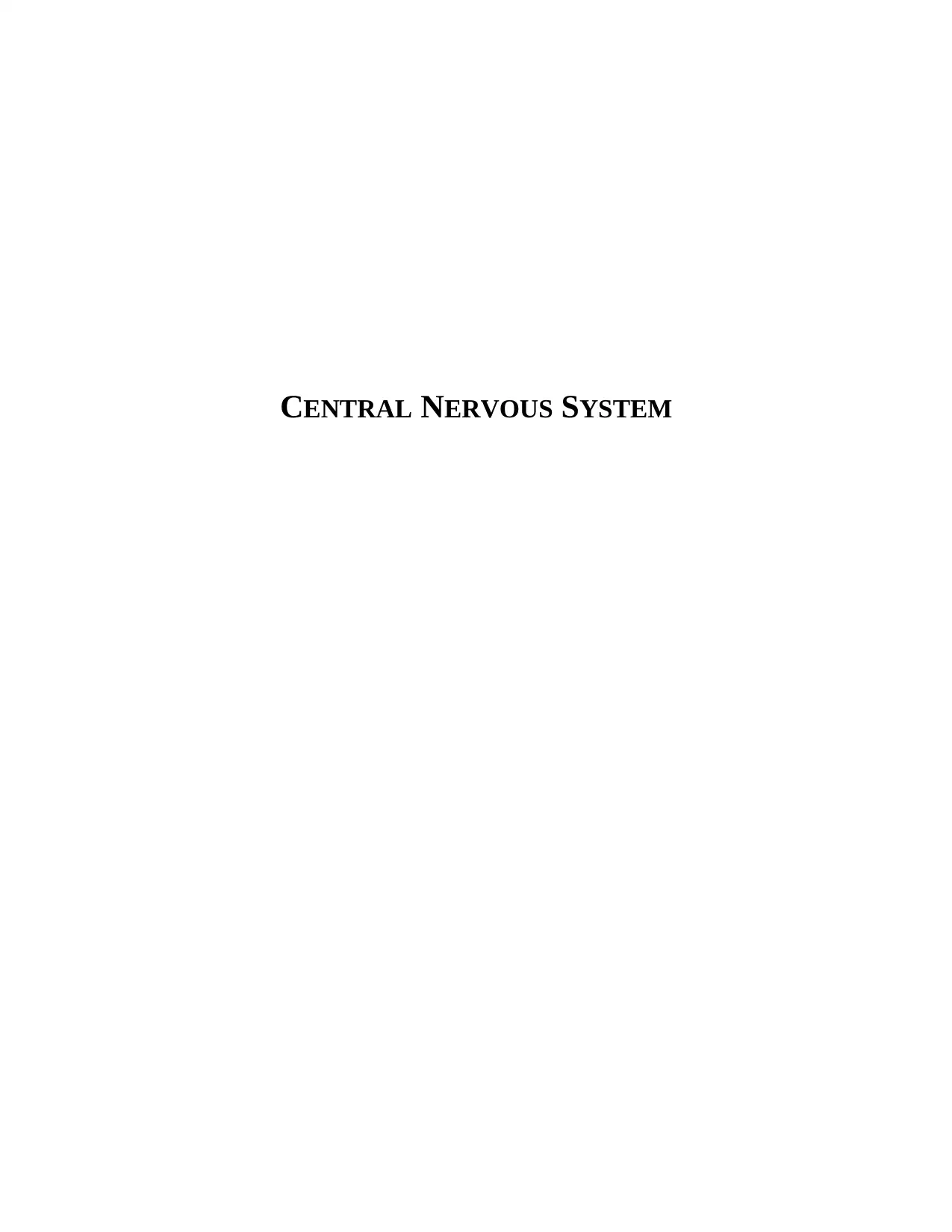
CENTRAL NERVOUS SYSTEM
Paraphrase This Document
Need a fresh take? Get an instant paraphrase of this document with our AI Paraphraser
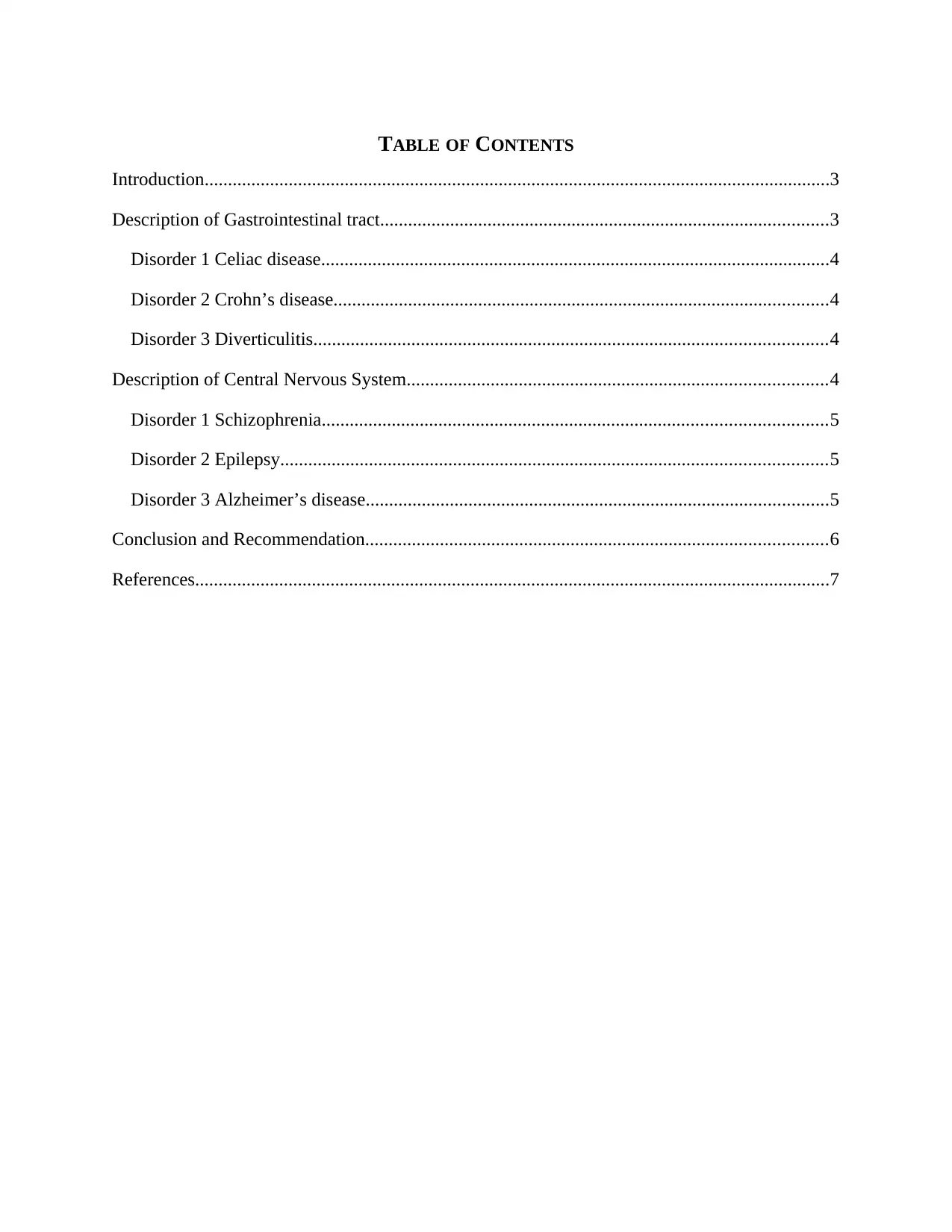
TABLE OF CONTENTS
Introduction......................................................................................................................................3
Description of Gastrointestinal tract................................................................................................3
Disorder 1 Celiac disease.............................................................................................................4
Disorder 2 Crohn’s disease..........................................................................................................4
Disorder 3 Diverticulitis..............................................................................................................4
Description of Central Nervous System..........................................................................................4
Disorder 1 Schizophrenia............................................................................................................5
Disorder 2 Epilepsy.....................................................................................................................5
Disorder 3 Alzheimer’s disease...................................................................................................5
Conclusion and Recommendation...................................................................................................6
References........................................................................................................................................7
Introduction......................................................................................................................................3
Description of Gastrointestinal tract................................................................................................3
Disorder 1 Celiac disease.............................................................................................................4
Disorder 2 Crohn’s disease..........................................................................................................4
Disorder 3 Diverticulitis..............................................................................................................4
Description of Central Nervous System..........................................................................................4
Disorder 1 Schizophrenia............................................................................................................5
Disorder 2 Epilepsy.....................................................................................................................5
Disorder 3 Alzheimer’s disease...................................................................................................5
Conclusion and Recommendation...................................................................................................6
References........................................................................................................................................7
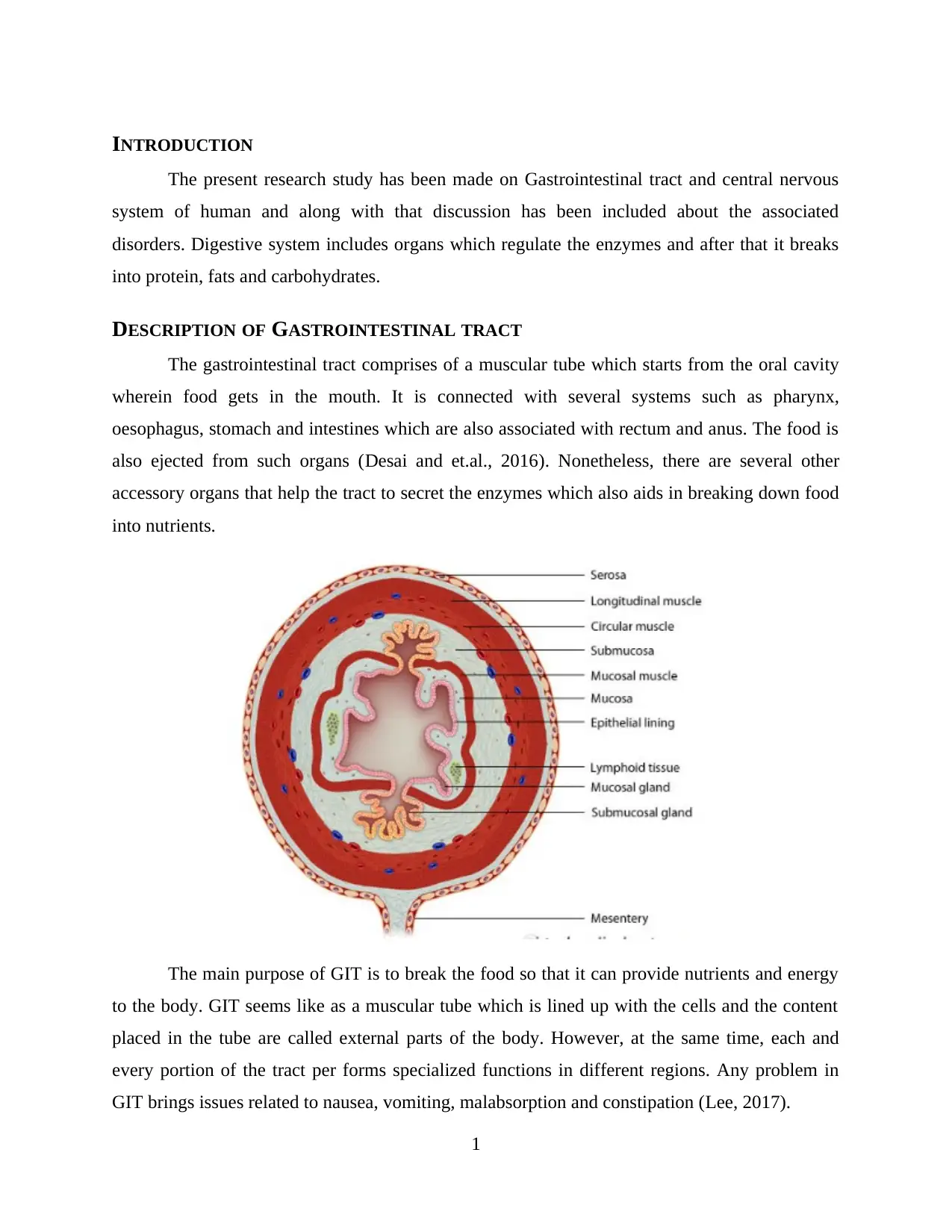
INTRODUCTION
The present research study has been made on Gastrointestinal tract and central nervous
system of human and along with that discussion has been included about the associated
disorders. Digestive system includes organs which regulate the enzymes and after that it breaks
into protein, fats and carbohydrates.
DESCRIPTION OF GASTROINTESTINAL TRACT
The gastrointestinal tract comprises of a muscular tube which starts from the oral cavity
wherein food gets in the mouth. It is connected with several systems such as pharynx,
oesophagus, stomach and intestines which are also associated with rectum and anus. The food is
also ejected from such organs (Desai and et.al., 2016). Nonetheless, there are several other
accessory organs that help the tract to secret the enzymes which also aids in breaking down food
into nutrients.
The main purpose of GIT is to break the food so that it can provide nutrients and energy
to the body. GIT seems like as a muscular tube which is lined up with the cells and the content
placed in the tube are called external parts of the body. However, at the same time, each and
every portion of the tract per forms specialized functions in different regions. Any problem in
GIT brings issues related to nausea, vomiting, malabsorption and constipation (Lee, 2017).
1
The present research study has been made on Gastrointestinal tract and central nervous
system of human and along with that discussion has been included about the associated
disorders. Digestive system includes organs which regulate the enzymes and after that it breaks
into protein, fats and carbohydrates.
DESCRIPTION OF GASTROINTESTINAL TRACT
The gastrointestinal tract comprises of a muscular tube which starts from the oral cavity
wherein food gets in the mouth. It is connected with several systems such as pharynx,
oesophagus, stomach and intestines which are also associated with rectum and anus. The food is
also ejected from such organs (Desai and et.al., 2016). Nonetheless, there are several other
accessory organs that help the tract to secret the enzymes which also aids in breaking down food
into nutrients.
The main purpose of GIT is to break the food so that it can provide nutrients and energy
to the body. GIT seems like as a muscular tube which is lined up with the cells and the content
placed in the tube are called external parts of the body. However, at the same time, each and
every portion of the tract per forms specialized functions in different regions. Any problem in
GIT brings issues related to nausea, vomiting, malabsorption and constipation (Lee, 2017).
1
⊘ This is a preview!⊘
Do you want full access?
Subscribe today to unlock all pages.

Trusted by 1+ million students worldwide
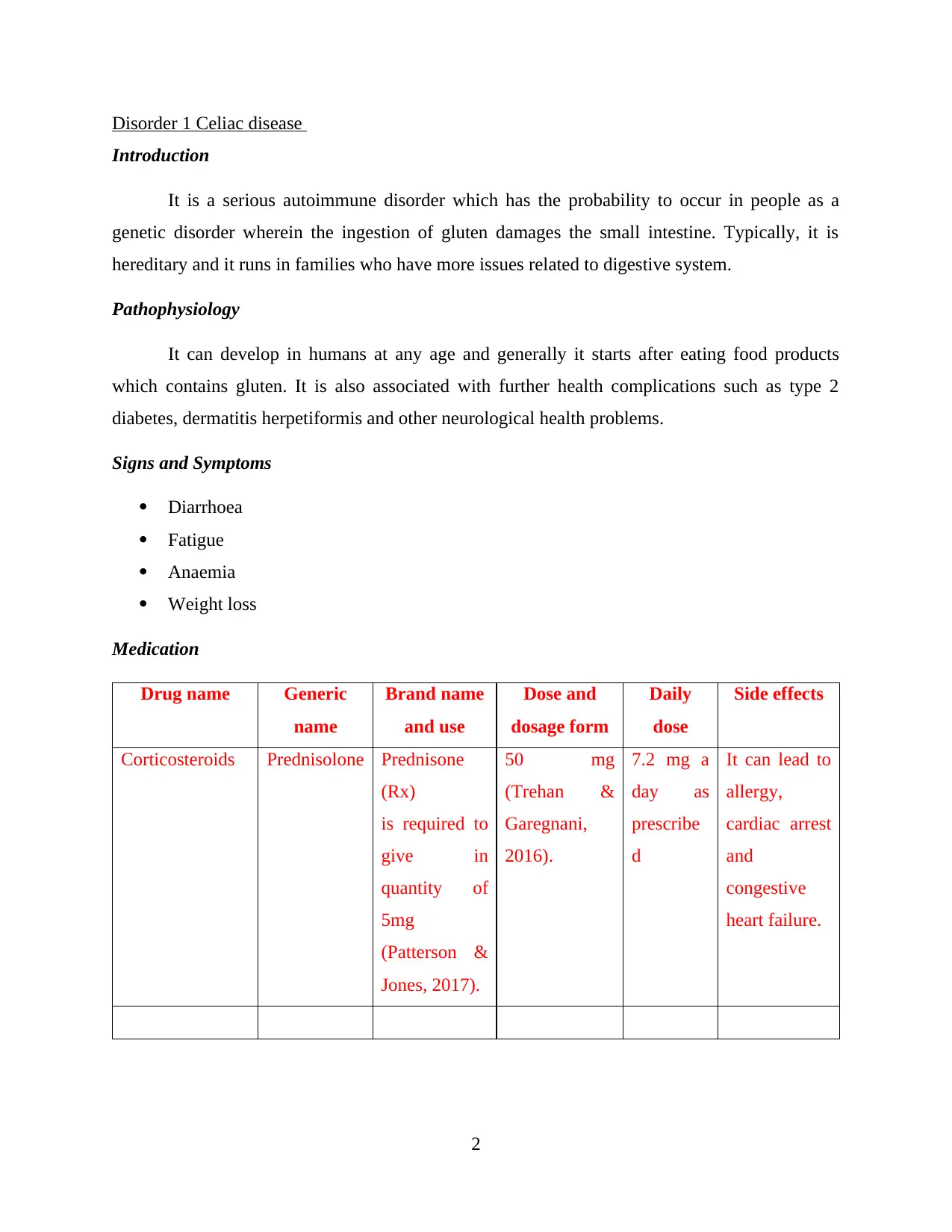
Disorder 1 Celiac disease
Introduction
It is a serious autoimmune disorder which has the probability to occur in people as a
genetic disorder wherein the ingestion of gluten damages the small intestine. Typically, it is
hereditary and it runs in families who have more issues related to digestive system.
Pathophysiology
It can develop in humans at any age and generally it starts after eating food products
which contains gluten. It is also associated with further health complications such as type 2
diabetes, dermatitis herpetiformis and other neurological health problems.
Signs and Symptoms
Diarrhoea
Fatigue
Anaemia
Weight loss
Medication
Drug name Generic
name
Brand name
and use
Dose and
dosage form
Daily
dose
Side effects
Corticosteroids Prednisolone Prednisone
(Rx)
is required to
give in
quantity of
5mg
(Patterson &
Jones, 2017).
50 mg
(Trehan &
Garegnani,
2016).
7.2 mg a
day as
prescribe
d
It can lead to
allergy,
cardiac arrest
and
congestive
heart failure.
2
Introduction
It is a serious autoimmune disorder which has the probability to occur in people as a
genetic disorder wherein the ingestion of gluten damages the small intestine. Typically, it is
hereditary and it runs in families who have more issues related to digestive system.
Pathophysiology
It can develop in humans at any age and generally it starts after eating food products
which contains gluten. It is also associated with further health complications such as type 2
diabetes, dermatitis herpetiformis and other neurological health problems.
Signs and Symptoms
Diarrhoea
Fatigue
Anaemia
Weight loss
Medication
Drug name Generic
name
Brand name
and use
Dose and
dosage form
Daily
dose
Side effects
Corticosteroids Prednisolone Prednisone
(Rx)
is required to
give in
quantity of
5mg
(Patterson &
Jones, 2017).
50 mg
(Trehan &
Garegnani,
2016).
7.2 mg a
day as
prescribe
d
It can lead to
allergy,
cardiac arrest
and
congestive
heart failure.
2
Paraphrase This Document
Need a fresh take? Get an instant paraphrase of this document with our AI Paraphraser
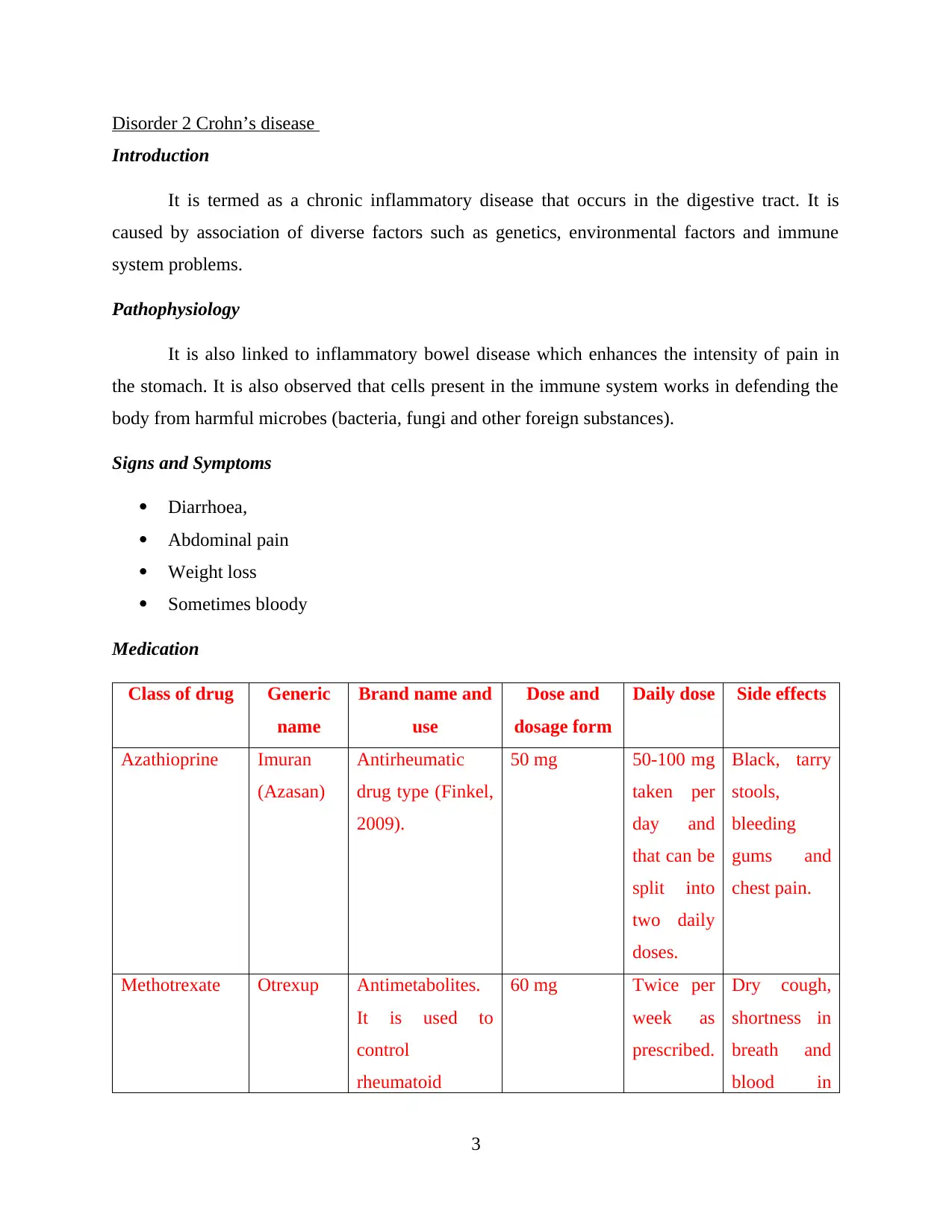
Disorder 2 Crohn’s disease
Introduction
It is termed as a chronic inflammatory disease that occurs in the digestive tract. It is
caused by association of diverse factors such as genetics, environmental factors and immune
system problems.
Pathophysiology
It is also linked to inflammatory bowel disease which enhances the intensity of pain in
the stomach. It is also observed that cells present in the immune system works in defending the
body from harmful microbes (bacteria, fungi and other foreign substances).
Signs and Symptoms
Diarrhoea,
Abdominal pain
Weight loss
Sometimes bloody
Medication
Class of drug Generic
name
Brand name and
use
Dose and
dosage form
Daily dose Side effects
Azathioprine Imuran
(Azasan)
Antirheumatic
drug type (Finkel,
2009).
50 mg 50-100 mg
taken per
day and
that can be
split into
two daily
doses.
Black, tarry
stools,
bleeding
gums and
chest pain.
Methotrexate Otrexup Antimetabolites.
It is used to
control
rheumatoid
60 mg Twice per
week as
prescribed.
Dry cough,
shortness in
breath and
blood in
3
Introduction
It is termed as a chronic inflammatory disease that occurs in the digestive tract. It is
caused by association of diverse factors such as genetics, environmental factors and immune
system problems.
Pathophysiology
It is also linked to inflammatory bowel disease which enhances the intensity of pain in
the stomach. It is also observed that cells present in the immune system works in defending the
body from harmful microbes (bacteria, fungi and other foreign substances).
Signs and Symptoms
Diarrhoea,
Abdominal pain
Weight loss
Sometimes bloody
Medication
Class of drug Generic
name
Brand name and
use
Dose and
dosage form
Daily dose Side effects
Azathioprine Imuran
(Azasan)
Antirheumatic
drug type (Finkel,
2009).
50 mg 50-100 mg
taken per
day and
that can be
split into
two daily
doses.
Black, tarry
stools,
bleeding
gums and
chest pain.
Methotrexate Otrexup Antimetabolites.
It is used to
control
rheumatoid
60 mg Twice per
week as
prescribed.
Dry cough,
shortness in
breath and
blood in
3
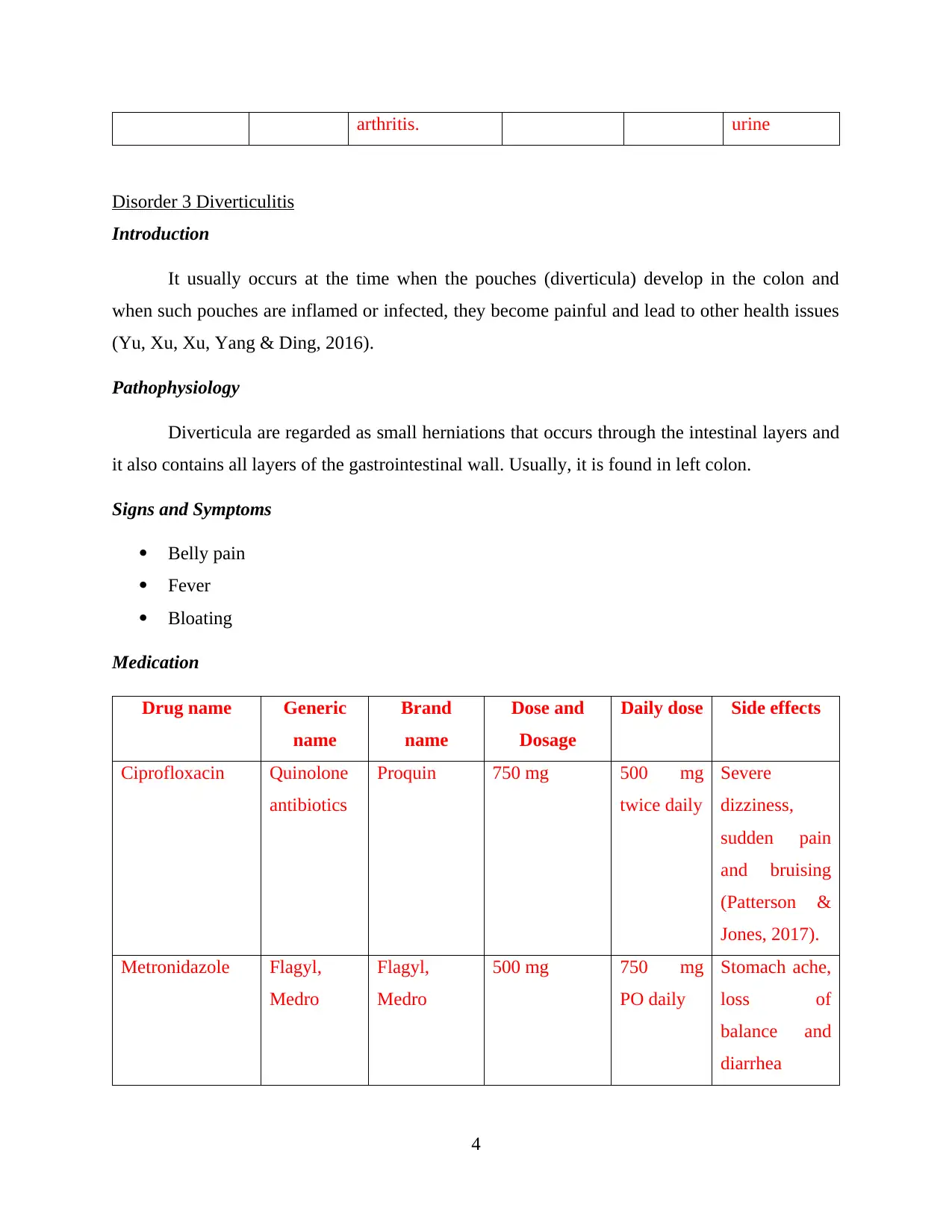
arthritis. urine
Disorder 3 Diverticulitis
Introduction
It usually occurs at the time when the pouches (diverticula) develop in the colon and
when such pouches are inflamed or infected, they become painful and lead to other health issues
(Yu, Xu, Xu, Yang & Ding, 2016).
Pathophysiology
Diverticula are regarded as small herniations that occurs through the intestinal layers and
it also contains all layers of the gastrointestinal wall. Usually, it is found in left colon.
Signs and Symptoms
Belly pain
Fever
Bloating
Medication
Drug name Generic
name
Brand
name
Dose and
Dosage
Daily dose Side effects
Ciprofloxacin Quinolone
antibiotics
Proquin 750 mg 500 mg
twice daily
Severe
dizziness,
sudden pain
and bruising
(Patterson &
Jones, 2017).
Metronidazole Flagyl,
Medro
Flagyl,
Medro
500 mg 750 mg
PO daily
Stomach ache,
loss of
balance and
diarrhea
4
Disorder 3 Diverticulitis
Introduction
It usually occurs at the time when the pouches (diverticula) develop in the colon and
when such pouches are inflamed or infected, they become painful and lead to other health issues
(Yu, Xu, Xu, Yang & Ding, 2016).
Pathophysiology
Diverticula are regarded as small herniations that occurs through the intestinal layers and
it also contains all layers of the gastrointestinal wall. Usually, it is found in left colon.
Signs and Symptoms
Belly pain
Fever
Bloating
Medication
Drug name Generic
name
Brand
name
Dose and
Dosage
Daily dose Side effects
Ciprofloxacin Quinolone
antibiotics
Proquin 750 mg 500 mg
twice daily
Severe
dizziness,
sudden pain
and bruising
(Patterson &
Jones, 2017).
Metronidazole Flagyl,
Medro
Flagyl,
Medro
500 mg 750 mg
PO daily
Stomach ache,
loss of
balance and
diarrhea
4
⊘ This is a preview!⊘
Do you want full access?
Subscribe today to unlock all pages.

Trusted by 1+ million students worldwide
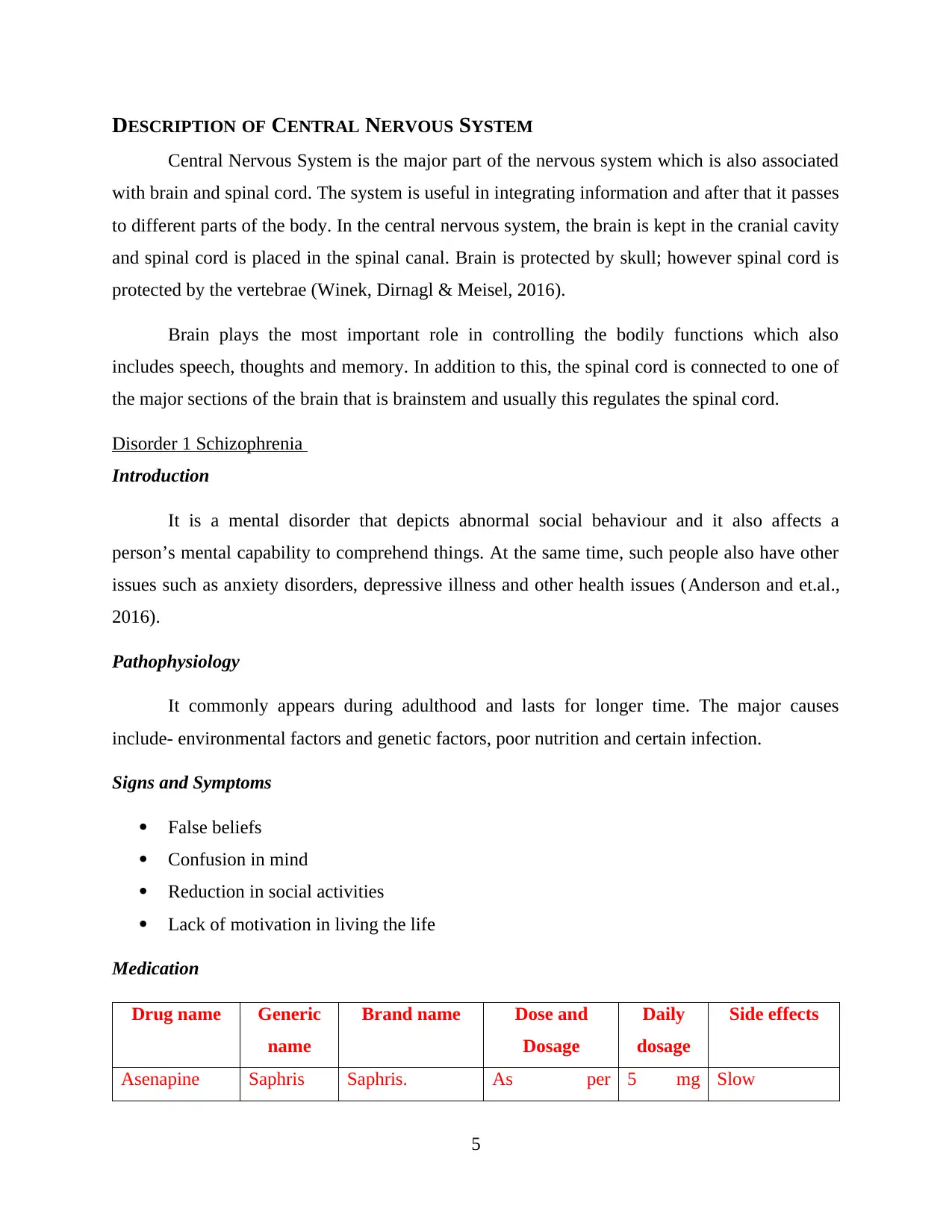
DESCRIPTION OF CENTRAL NERVOUS SYSTEM
Central Nervous System is the major part of the nervous system which is also associated
with brain and spinal cord. The system is useful in integrating information and after that it passes
to different parts of the body. In the central nervous system, the brain is kept in the cranial cavity
and spinal cord is placed in the spinal canal. Brain is protected by skull; however spinal cord is
protected by the vertebrae (Winek, Dirnagl & Meisel, 2016).
Brain plays the most important role in controlling the bodily functions which also
includes speech, thoughts and memory. In addition to this, the spinal cord is connected to one of
the major sections of the brain that is brainstem and usually this regulates the spinal cord.
Disorder 1 Schizophrenia
Introduction
It is a mental disorder that depicts abnormal social behaviour and it also affects a
person’s mental capability to comprehend things. At the same time, such people also have other
issues such as anxiety disorders, depressive illness and other health issues (Anderson and et.al.,
2016).
Pathophysiology
It commonly appears during adulthood and lasts for longer time. The major causes
include- environmental factors and genetic factors, poor nutrition and certain infection.
Signs and Symptoms
False beliefs
Confusion in mind
Reduction in social activities
Lack of motivation in living the life
Medication
Drug name Generic
name
Brand name Dose and
Dosage
Daily
dosage
Side effects
Asenapine Saphris Saphris. As per 5 mg Slow
5
Central Nervous System is the major part of the nervous system which is also associated
with brain and spinal cord. The system is useful in integrating information and after that it passes
to different parts of the body. In the central nervous system, the brain is kept in the cranial cavity
and spinal cord is placed in the spinal canal. Brain is protected by skull; however spinal cord is
protected by the vertebrae (Winek, Dirnagl & Meisel, 2016).
Brain plays the most important role in controlling the bodily functions which also
includes speech, thoughts and memory. In addition to this, the spinal cord is connected to one of
the major sections of the brain that is brainstem and usually this regulates the spinal cord.
Disorder 1 Schizophrenia
Introduction
It is a mental disorder that depicts abnormal social behaviour and it also affects a
person’s mental capability to comprehend things. At the same time, such people also have other
issues such as anxiety disorders, depressive illness and other health issues (Anderson and et.al.,
2016).
Pathophysiology
It commonly appears during adulthood and lasts for longer time. The major causes
include- environmental factors and genetic factors, poor nutrition and certain infection.
Signs and Symptoms
False beliefs
Confusion in mind
Reduction in social activities
Lack of motivation in living the life
Medication
Drug name Generic
name
Brand name Dose and
Dosage
Daily
dosage
Side effects
Asenapine Saphris Saphris. As per 5 mg Slow
5
Paraphrase This Document
Need a fresh take? Get an instant paraphrase of this document with our AI Paraphraser
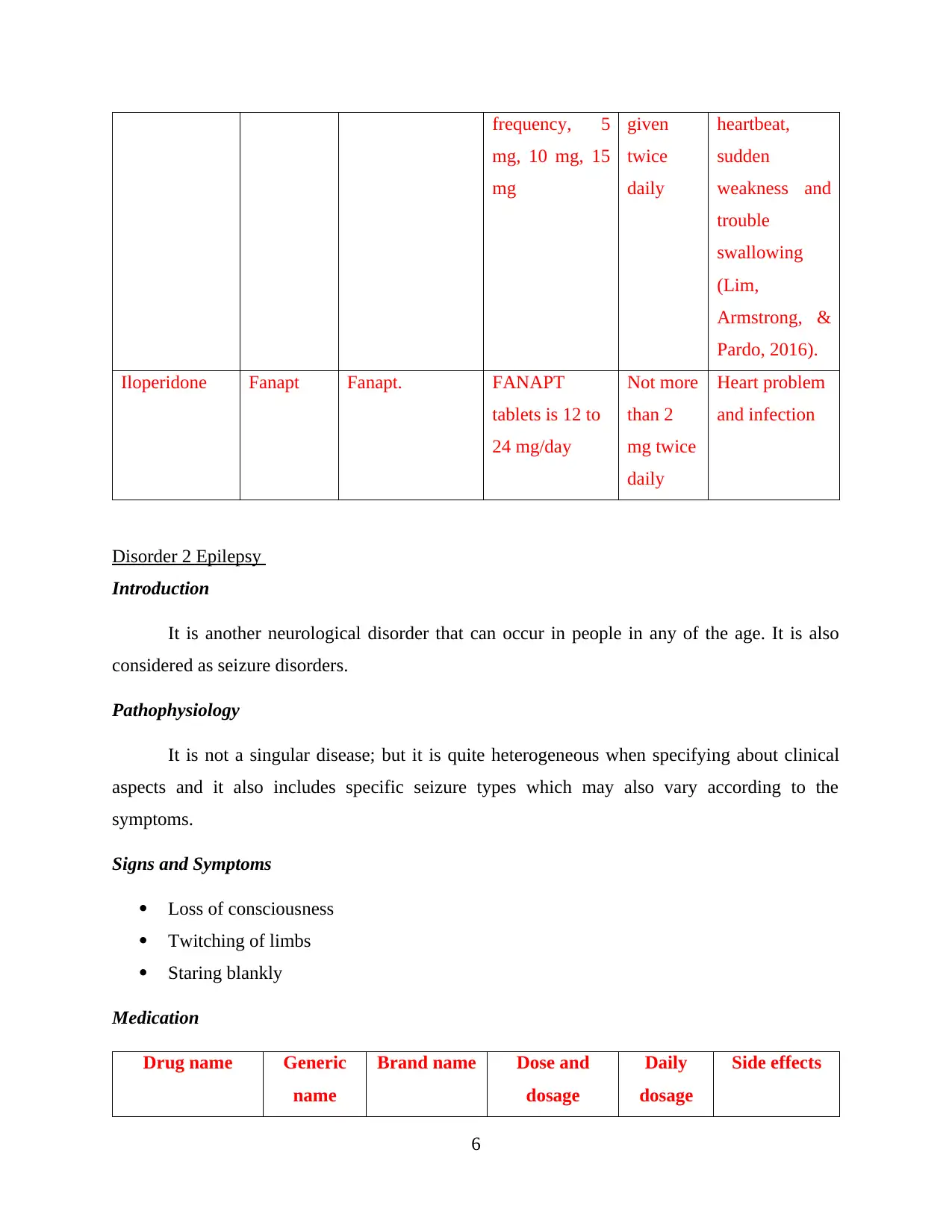
frequency, 5
mg, 10 mg, 15
mg
given
twice
daily
heartbeat,
sudden
weakness and
trouble
swallowing
(Lim,
Armstrong, &
Pardo, 2016).
Iloperidone Fanapt Fanapt. FANAPT
tablets is 12 to
24 mg/day
Not more
than 2
mg twice
daily
Heart problem
and infection
Disorder 2 Epilepsy
Introduction
It is another neurological disorder that can occur in people in any of the age. It is also
considered as seizure disorders.
Pathophysiology
It is not a singular disease; but it is quite heterogeneous when specifying about clinical
aspects and it also includes specific seizure types which may also vary according to the
symptoms.
Signs and Symptoms
Loss of consciousness
Twitching of limbs
Staring blankly
Medication
Drug name Generic
name
Brand name Dose and
dosage
Daily
dosage
Side effects
6
mg, 10 mg, 15
mg
given
twice
daily
heartbeat,
sudden
weakness and
trouble
swallowing
(Lim,
Armstrong, &
Pardo, 2016).
Iloperidone Fanapt Fanapt. FANAPT
tablets is 12 to
24 mg/day
Not more
than 2
mg twice
daily
Heart problem
and infection
Disorder 2 Epilepsy
Introduction
It is another neurological disorder that can occur in people in any of the age. It is also
considered as seizure disorders.
Pathophysiology
It is not a singular disease; but it is quite heterogeneous when specifying about clinical
aspects and it also includes specific seizure types which may also vary according to the
symptoms.
Signs and Symptoms
Loss of consciousness
Twitching of limbs
Staring blankly
Medication
Drug name Generic
name
Brand name Dose and
dosage
Daily
dosage
Side effects
6
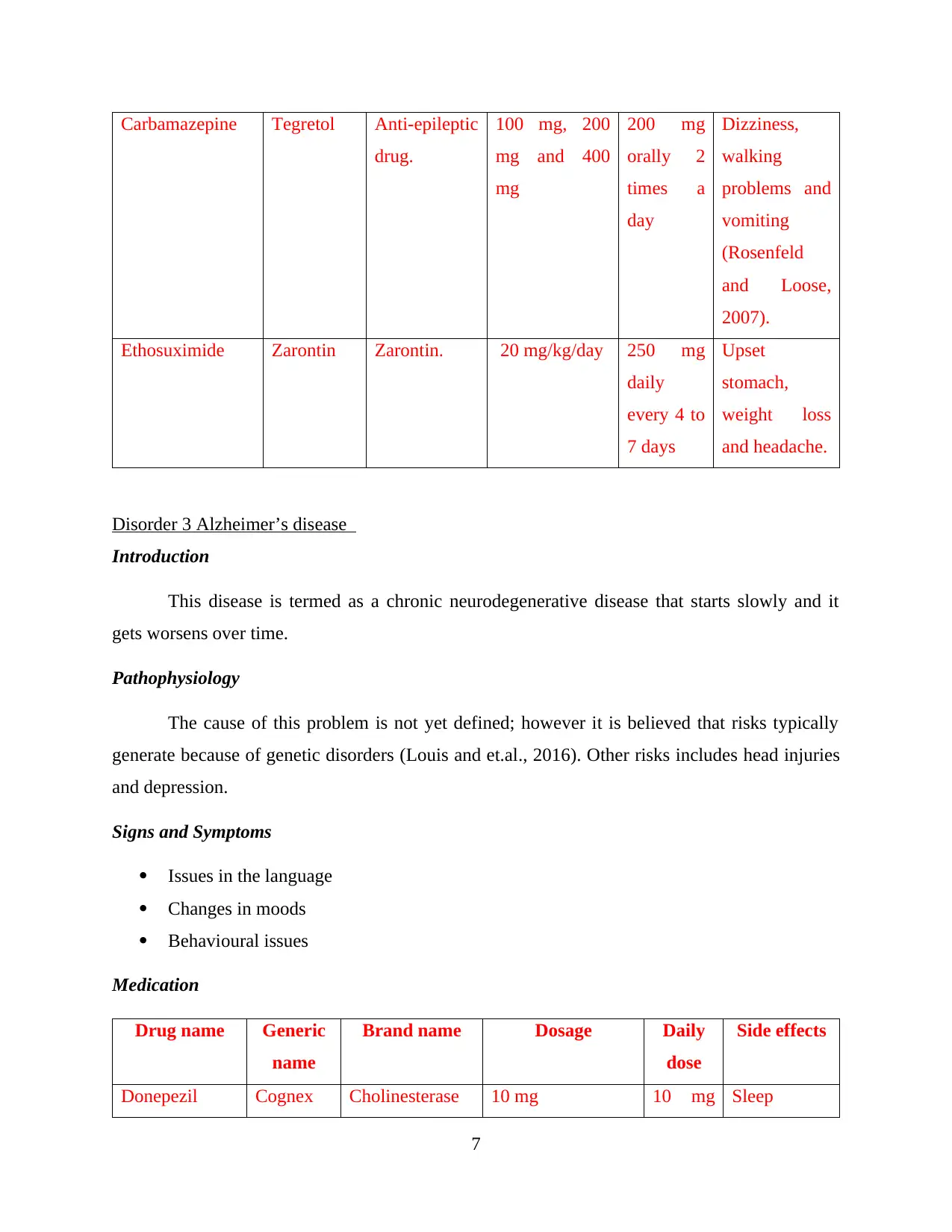
Carbamazepine Tegretol Anti-epileptic
drug.
100 mg, 200
mg and 400
mg
200 mg
orally 2
times a
day
Dizziness,
walking
problems and
vomiting
(Rosenfeld
and Loose,
2007).
Ethosuximide Zarontin Zarontin. 20 mg/kg/day 250 mg
daily
every 4 to
7 days
Upset
stomach,
weight loss
and headache.
Disorder 3 Alzheimer’s disease
Introduction
This disease is termed as a chronic neurodegenerative disease that starts slowly and it
gets worsens over time.
Pathophysiology
The cause of this problem is not yet defined; however it is believed that risks typically
generate because of genetic disorders (Louis and et.al., 2016). Other risks includes head injuries
and depression.
Signs and Symptoms
Issues in the language
Changes in moods
Behavioural issues
Medication
Drug name Generic
name
Brand name Dosage Daily
dose
Side effects
Donepezil Cognex Cholinesterase 10 mg 10 mg Sleep
7
drug.
100 mg, 200
mg and 400
mg
200 mg
orally 2
times a
day
Dizziness,
walking
problems and
vomiting
(Rosenfeld
and Loose,
2007).
Ethosuximide Zarontin Zarontin. 20 mg/kg/day 250 mg
daily
every 4 to
7 days
Upset
stomach,
weight loss
and headache.
Disorder 3 Alzheimer’s disease
Introduction
This disease is termed as a chronic neurodegenerative disease that starts slowly and it
gets worsens over time.
Pathophysiology
The cause of this problem is not yet defined; however it is believed that risks typically
generate because of genetic disorders (Louis and et.al., 2016). Other risks includes head injuries
and depression.
Signs and Symptoms
Issues in the language
Changes in moods
Behavioural issues
Medication
Drug name Generic
name
Brand name Dosage Daily
dose
Side effects
Donepezil Cognex Cholinesterase 10 mg 10 mg Sleep
7
⊘ This is a preview!⊘
Do you want full access?
Subscribe today to unlock all pages.

Trusted by 1+ million students worldwide
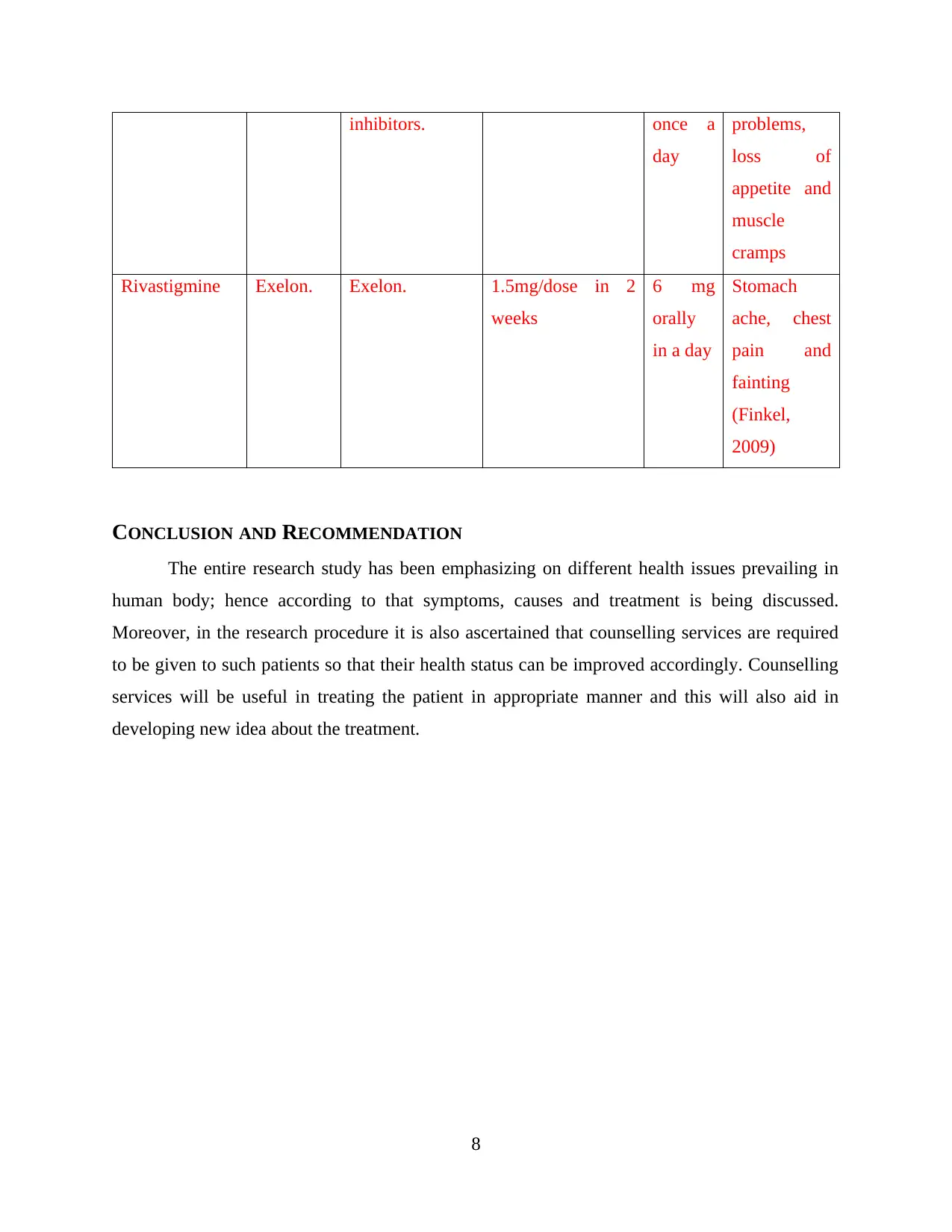
inhibitors. once a
day
problems,
loss of
appetite and
muscle
cramps
Rivastigmine Exelon. Exelon. 1.5mg/dose in 2
weeks
6 mg
orally
in a day
Stomach
ache, chest
pain and
fainting
(Finkel,
2009)
CONCLUSION AND RECOMMENDATION
The entire research study has been emphasizing on different health issues prevailing in
human body; hence according to that symptoms, causes and treatment is being discussed.
Moreover, in the research procedure it is also ascertained that counselling services are required
to be given to such patients so that their health status can be improved accordingly. Counselling
services will be useful in treating the patient in appropriate manner and this will also aid in
developing new idea about the treatment.
8
day
problems,
loss of
appetite and
muscle
cramps
Rivastigmine Exelon. Exelon. 1.5mg/dose in 2
weeks
6 mg
orally
in a day
Stomach
ache, chest
pain and
fainting
(Finkel,
2009)
CONCLUSION AND RECOMMENDATION
The entire research study has been emphasizing on different health issues prevailing in
human body; hence according to that symptoms, causes and treatment is being discussed.
Moreover, in the research procedure it is also ascertained that counselling services are required
to be given to such patients so that their health status can be improved accordingly. Counselling
services will be useful in treating the patient in appropriate manner and this will also aid in
developing new idea about the treatment.
8
Paraphrase This Document
Need a fresh take? Get an instant paraphrase of this document with our AI Paraphraser
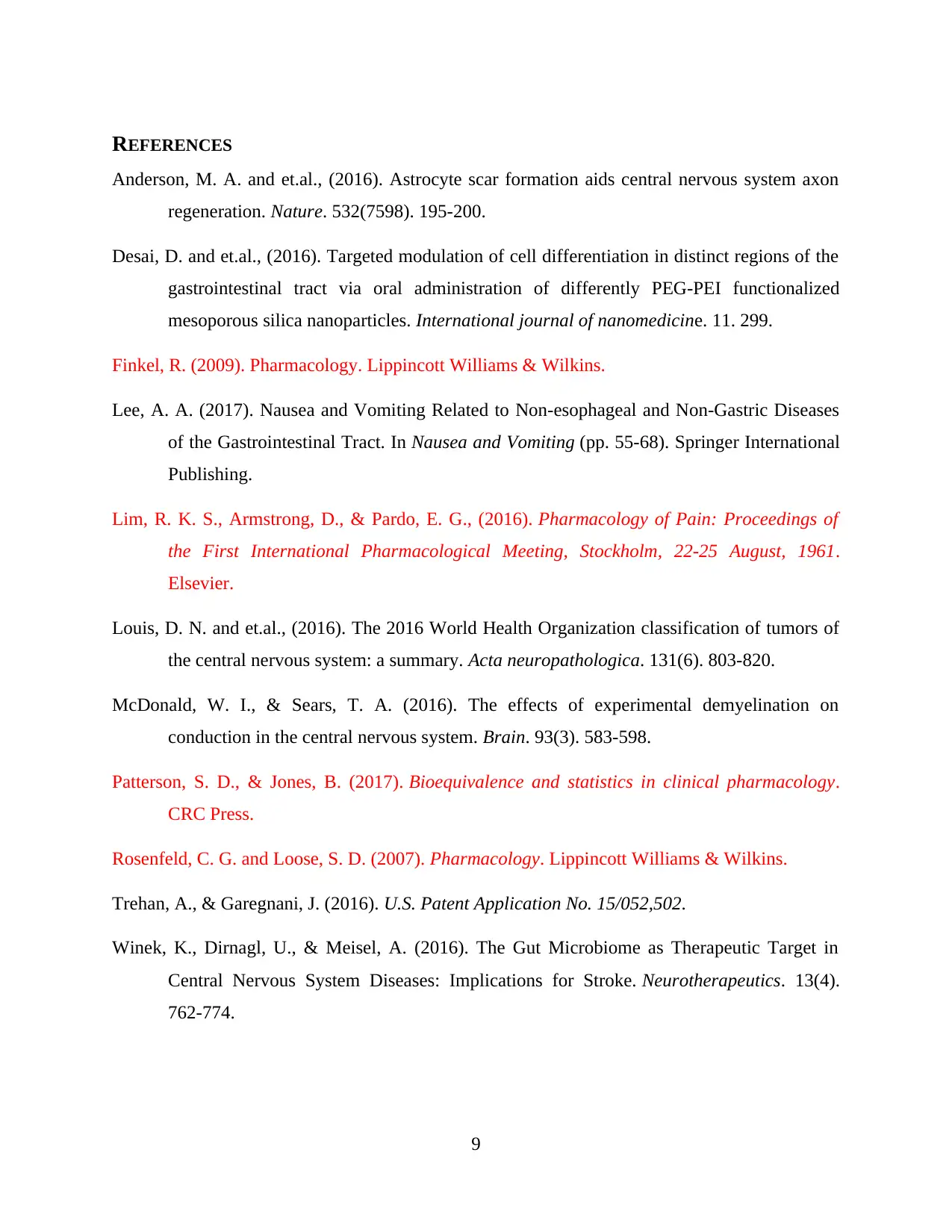
REFERENCES
Anderson, M. A. and et.al., (2016). Astrocyte scar formation aids central nervous system axon
regeneration. Nature. 532(7598). 195-200.
Desai, D. and et.al., (2016). Targeted modulation of cell differentiation in distinct regions of the
gastrointestinal tract via oral administration of differently PEG-PEI functionalized
mesoporous silica nanoparticles. International journal of nanomedicine. 11. 299.
Finkel, R. (2009). Pharmacology. Lippincott Williams & Wilkins.
Lee, A. A. (2017). Nausea and Vomiting Related to Non-esophageal and Non-Gastric Diseases
of the Gastrointestinal Tract. In Nausea and Vomiting (pp. 55-68). Springer International
Publishing.
Lim, R. K. S., Armstrong, D., & Pardo, E. G., (2016). Pharmacology of Pain: Proceedings of
the First International Pharmacological Meeting, Stockholm, 22-25 August, 1961.
Elsevier.
Louis, D. N. and et.al., (2016). The 2016 World Health Organization classification of tumors of
the central nervous system: a summary. Acta neuropathologica. 131(6). 803-820.
McDonald, W. I., & Sears, T. A. (2016). The effects of experimental demyelination on
conduction in the central nervous system. Brain. 93(3). 583-598.
Patterson, S. D., & Jones, B. (2017). Bioequivalence and statistics in clinical pharmacology.
CRC Press.
Rosenfeld, C. G. and Loose, S. D. (2007). Pharmacology. Lippincott Williams & Wilkins.
Trehan, A., & Garegnani, J. (2016). U.S. Patent Application No. 15/052,502.
Winek, K., Dirnagl, U., & Meisel, A. (2016). The Gut Microbiome as Therapeutic Target in
Central Nervous System Diseases: Implications for Stroke. Neurotherapeutics. 13(4).
762-774.
9
Anderson, M. A. and et.al., (2016). Astrocyte scar formation aids central nervous system axon
regeneration. Nature. 532(7598). 195-200.
Desai, D. and et.al., (2016). Targeted modulation of cell differentiation in distinct regions of the
gastrointestinal tract via oral administration of differently PEG-PEI functionalized
mesoporous silica nanoparticles. International journal of nanomedicine. 11. 299.
Finkel, R. (2009). Pharmacology. Lippincott Williams & Wilkins.
Lee, A. A. (2017). Nausea and Vomiting Related to Non-esophageal and Non-Gastric Diseases
of the Gastrointestinal Tract. In Nausea and Vomiting (pp. 55-68). Springer International
Publishing.
Lim, R. K. S., Armstrong, D., & Pardo, E. G., (2016). Pharmacology of Pain: Proceedings of
the First International Pharmacological Meeting, Stockholm, 22-25 August, 1961.
Elsevier.
Louis, D. N. and et.al., (2016). The 2016 World Health Organization classification of tumors of
the central nervous system: a summary. Acta neuropathologica. 131(6). 803-820.
McDonald, W. I., & Sears, T. A. (2016). The effects of experimental demyelination on
conduction in the central nervous system. Brain. 93(3). 583-598.
Patterson, S. D., & Jones, B. (2017). Bioequivalence and statistics in clinical pharmacology.
CRC Press.
Rosenfeld, C. G. and Loose, S. D. (2007). Pharmacology. Lippincott Williams & Wilkins.
Trehan, A., & Garegnani, J. (2016). U.S. Patent Application No. 15/052,502.
Winek, K., Dirnagl, U., & Meisel, A. (2016). The Gut Microbiome as Therapeutic Target in
Central Nervous System Diseases: Implications for Stroke. Neurotherapeutics. 13(4).
762-774.
9
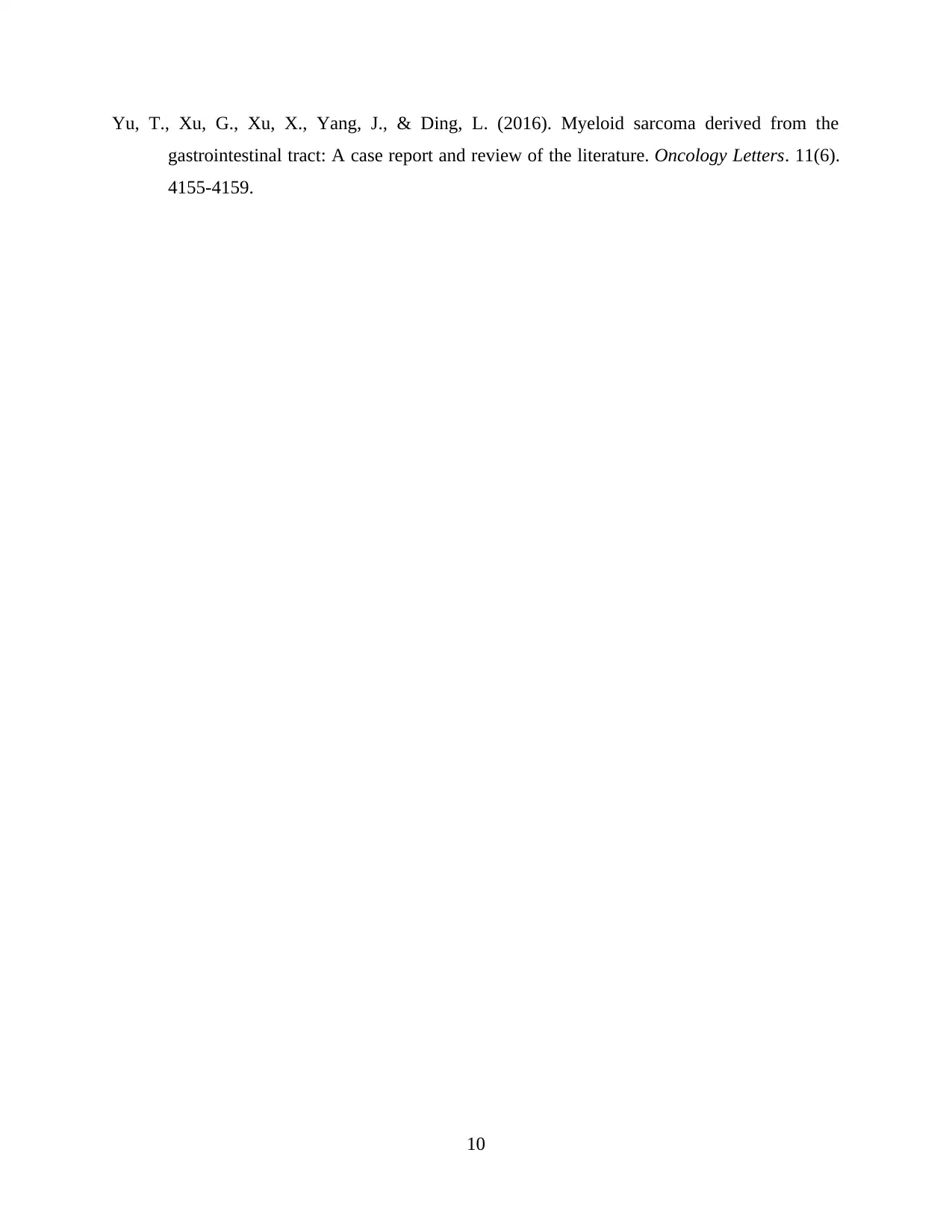
Yu, T., Xu, G., Xu, X., Yang, J., & Ding, L. (2016). Myeloid sarcoma derived from the
gastrointestinal tract: A case report and review of the literature. Oncology Letters. 11(6).
4155-4159.
10
gastrointestinal tract: A case report and review of the literature. Oncology Letters. 11(6).
4155-4159.
10
⊘ This is a preview!⊘
Do you want full access?
Subscribe today to unlock all pages.

Trusted by 1+ million students worldwide
1 out of 12
Related Documents
Your All-in-One AI-Powered Toolkit for Academic Success.
+13062052269
info@desklib.com
Available 24*7 on WhatsApp / Email
![[object Object]](/_next/static/media/star-bottom.7253800d.svg)
Unlock your academic potential
Copyright © 2020–2025 A2Z Services. All Rights Reserved. Developed and managed by ZUCOL.





